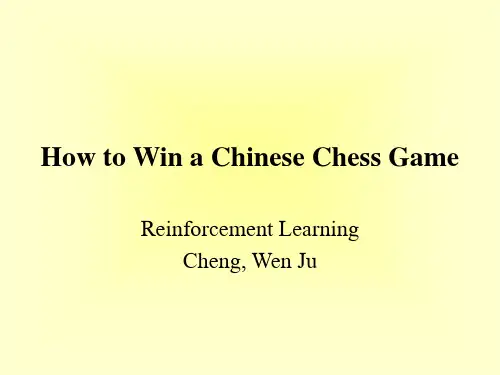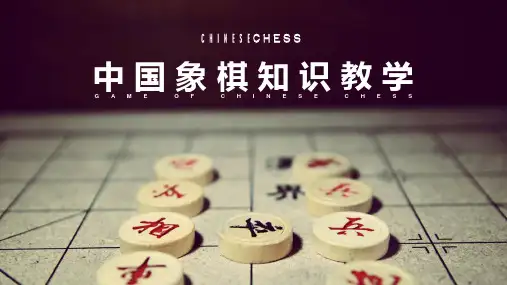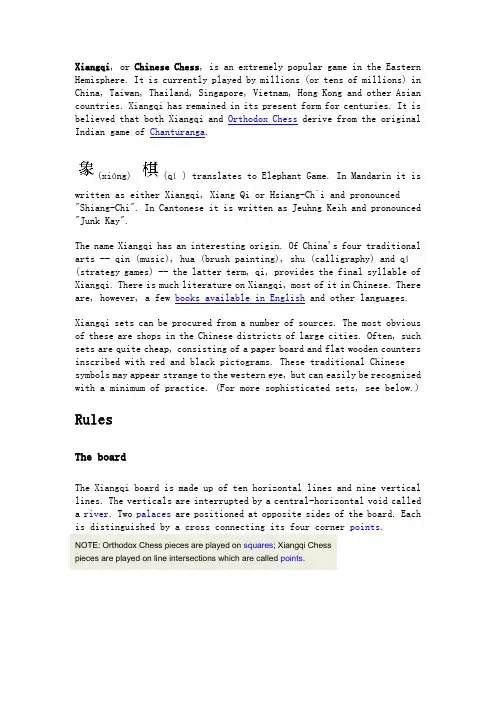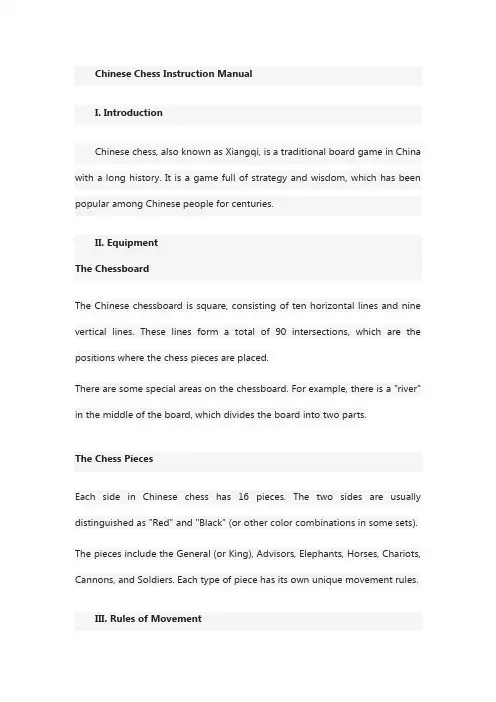中国象棋ppt英文模板
- 格式:pptx
- 大小:2.44 MB
- 文档页数:24



Xiangqi, or Chinese Chess, is an extremely popular game in the Eastern Hemisphere. It is currently played by millions (or tens of millions) in China, Taiwan, Thailand, Singapore, Vietnam, Hong Kong and other Asian countries. Xiangqi has remained in its present form for centuries. It is believed that both Xiangqi and Orthodox Chess derive from the original Indian game of Chanturanga.(xiáng) (qí ) translates to Elephant Game. In Mandarin it iswritten as either Xiangqi, Xiang Qi or Hsiang-Ch`i and pronounced "Shiang-Chi". In Cantonese it is written as Jeuhng Keih and pronounced "Junk Kay".The name Xiangqi has an interesting origin. Of China's four traditional arts -- qin (music), hua (brush pai nting), shu (calligraphy) and qí (strategy games) -- the latter term, qi, provides the final syllable of Xiangqi. There is much literature on Xiangqi, most of it in Chinese. There are, however, a few books available in English and other languages.Xiangqi sets can be procured from a number of sources. The most obvious of these are shops in the Chinese districts of large cities. Often, such sets are quite cheap, consisting of a paper board and flat wooden counters inscribed with red and black pictograms. These traditional Chinese symbols may appear strange to the western eye, but can easily be recognized with a minimum of practice. (For more sophisticated sets, see below.)RulesThe boardThe Xiangqi board is made up of ten horizontal lines and nine vertical lines. The verticals are interrupted by a central-horizontal void called a river. Two palaces are positioned at opposite sides of the board. Each is distinguished by a cross connecting its four corner points.NOTE: Orthodox Chess pieces are played on squares; Xiangqi Chesspieces are played on line intersections which are called points.The above board shows various L-shaped markings in order to distinguish the setup points of Pawns and Cannons. These markings are not present on all commercial boards.PiecesEach player has the following pieces:2 Rooks (R) (or chariots)2 Knights (N) (or horses)2 Elephants (M) (or bishops or ministers)2 Mandarins (G) (or advisors or assistants or guards)1 King (K) (or generals)2 Cannons (C)5 Pawns (P) (or soldiers)The Xiangqi array is shown below:Traditional Pieces Westernized PiecesFrom left to right on the bottom and top rows, you see: a Rook, a Knight, a Minister, a Guard, a King, a Guard, a Minister, a Knight, and a Rook. On the third rows, you see the Cannons, and on the fourth row you see the Pawns. Pieces at the bottom half are red.Chinese PiecesMovementWesternizedPieces RooksThe Rook moves as an orthodox Rook. (See Rook formore information.)Knights (Mao)The Knight moves one point orthogonally followedby one point outward-diagonally. It may not leapover occupied points. (See Mao for moreinformation.)ElephantsThe Elephant moves exactly two pointsdiagonally. It may not leap over occupied points. Also, Elephants are confined to their home side of the river. Due to these limitations, the Elephant can see only seven points of the board. (See Elephant for more information.) [The symbols on red and black Elephants differ, but their moves are the same.]MandarinsThe Mandarin (or Guard) moves one point diagonally. It may never leave the palace. [The symbols on red and black Mandrians differ, but their moves are the same.]King or GeneralThe King moves as an orthodox King, but cannot move diagonally. It may never leave the palace. (See King for more information.) [The symbols on red and black Kings differ, but their moves are the same.]The two Kings cannot face each other on an open file. For example, a red King on e1 and a black King on e9, with no piece on the e-file between them, is an illegal position. If either King sits exposed on an open file, the other King may not move to occupy that file.Cannons (Pao)The Cannon moves differently when it moves to capture than when it moves passively.1.The Cannon moves passively as an orthodoxRook2.The Cannon moves to capture as an orthodoxRook which is required to hop over a singlescreen.In other words, Cannons capture by hoping overa second piece in order to capture a third piece.For example, a Cannon on a1 can take a piece onf1 when exactly one of the points b1, c1, d1, ore1 is occupied by a piece of either color. Cannonsonly capture when hoping and only hop whencapturing. They may never hop over more than onepiece in a given move. (See Cannon for moreinformation.)PawnsUnlike orthodox Pawns, the Xiangqi Pawn'spassive move and capture move are always thesame. A starting Pawn moves one pointstraight-forward. A Pawn crossing the riverpromotes, keeping its old move and gaining a newmove -- a one-point step to either horizontal.Pawns do not promote on the last rank, where theycan move only left or right. (See Xiangqi Pawnfor more information.) [The symbols on red andblack Pawns differ, but their moves are thesame.]Other rules1.Red moves first.2.The game is won by checkmating or stalemating the opponent King.3.Perpetual check is forbidden. You cannot check your opponent morethan three times in a row with the same piece and same boardpositions.4.You cannot force an enemy piece to move to and from the same twopoints, indefinitely, in order to avoid capture. If you move a Rook to e5, threatening a Cannon on e6, and your opponent's only viable move is Cannon to f6, then you cannot force that Cannon to and from e6 and f6 by moving your Rook to and from e5 and f5, indefinitely.The purpose of this rule (and the above rule) is to avoidperpetual-check draws. Some of these situations are complicated, but the person who is forcing the perpetual move must usually break it off.5.The game is a draw when neither side can force a checkmate or astalemate.。




Chinese Chess Instruction ManualI. IntroductionChinese chess, also known as Xiangqi, is a traditional board game in China with a long history. It is a game full of strategy and wisdom, which has been popular among Chinese people for centuries.II. EquipmentThe ChessboardThe Chinese chessboard is square, consisting of ten horizontal lines and nine vertical lines. These lines form a total of 90 intersections, which are the positions where the chess pieces are placed.There are some special areas on the chessboard. For example, there is a "river" in the middle of the board, which divides the board into two parts.The Chess PiecesEach side in Chinese chess has 16 pieces. The two sides are usually distinguished as "Red" and "Black" (or other color combinations in some sets). The pieces include the General (or King), Advisors, Elephants, Horses, Chariots, Cannons, and Soldiers. Each type of piece has its own unique movement rules.III. Rules of MovementGeneral (King)The General can only move one step at a time, either horizontally or vertically, within the "palace" area, which is a small square area in the center of each side's territory.AdvisorsAdvisors can only move diagonally within the "palace" area, also one step at a time.ElephantsElephants move two squares diagonally. However, they cannot cross the "river", and there is a so - called "blocking elephant's eye" rule. If there is a piece (of either side) on the square adjacent to the elephant's starting point in the middle of its diagonal movement path, the elephant cannot move in that direction.HorsesHorses move in an L - shape, which means one square horizontally or vertically and then one square diagonally. If there is a piece on the square immediately next to the horse in the direction of its first move (horizontally or vertically), the horse is "blocked" and cannot move in that L - shape in that direction. This is known as "horse's hoof - blocked".ChariotsChariots can move any number of squares horizontally or vertically as long as there are no other pieces blocking their path. They are very powerful pieces for attacking and defending.CannonsCannons move like chariots, but when they want to "capture" an enemy piece, they need to have a "jump - over" piece (of either side). That is, there must be a piece between the cannon and the piece it wants to capture, and then it can jump over this piece to capture the target piece.SoldiersSoldiers can only move one step forward when they are on their own side of the "river". Once they cross the "river", they can move one step forward or one step horizontally (left or right).IV. Rules of the GameStarting PositionAt the beginning of the game, all the pieces are placed in their initial positions on the chessboard according to the rules.Taking TurnsThe two players take turns to move their pieces. Usually, Red moves first. Objective of the GameThe goal of the game is to checkmate the opponent's General (King). That is, to put the opponent's General in a position where it is under attack and has no legal move to escape.If a player's General is in a "stalemate" situation (where the General is not in check but has no legal move), the game is considered a draw.There are also some other situations that can result in a draw, such as both sides agreeing to a draw, or when a certain number of moves are repeated without any significant progress in the game.Capturing PiecesWhen a piece moves to a position where it can capture an opponent's piece according to the movement rules, the opponent's piece is removed from the board.V. Tips and StrategiesEarly - Game StrategiesIn the early game, it is important to develop your pieces quickly and control key areas of the chessboard. For example, chariots can be moved out early to gain control of the main lines (horizontal and vertical).Protecting your important pieces, such as the General and Advisors, is also crucial in the early stage.Mid - Game StrategiesAs the game progresses, look for opportunities to attack the opponent's weaknesses. Coordinate the movement of different pieces, such as using horses and cannons together to create threats.Try to break through the opponent's defense line by using a combination of pieces.Late - Game StrategiesIn the late game, when there are fewer pieces on the board, be more cautious with each move. The position of the General becomes even more critical, and one wrong move can lead to a quick defeat.Try to simplify the game situation if you have an advantage, or look for ways to create a draw if you are at a disadvantage.。


中国象棋Chinese ChessKey: 将/帅:King 车:Rook 马:Knight 象/相: Minister 士/仕:Guard 炮:cannon 兵/卒:PawnRule:The Chinese chess board is made up of ten horizontal lines and nine vertical lines. The verticals are interrupted by a central-horizontal void called a river. Two palaces are positioned at opposite sides of the board. Each is distinguished by a cross connecting its four corner points.The King moves only one space at a time, either horizontally or vertically, but cannot move diagonally. It may never leave the palace, which is a square marked with an X. The two Kings cannot face each other on an open file. If either King sits exposed on an open file, the other King may not move to occupy that file.The Rook moves one or more spaces horizontally or vertically provided that all positions between the original and final positions are empty.The Knight moves two points horizontally and one point vertically (or respectively 2 points vertically and 1 point horizontally). If there is a piece next to the horse in the horizontal (vertical) direction, the horse is blocked and the move is not allowed.The Minister moves exactly two points diagonally. If there is a piece midway between the original and final intended position of a minister, the Minister is blocked and the move is not allowed. Also, Ministers are confined to their home side of the river. Due to these limitations, the Minister can see only seven points of the board.The Guard moves one point diagonally. It may never leave the palace. Due to these limitations, the Guard can see only five points of the board.The Cannon moves differently when it moves to capture than when it moves passively. It moves one or more points horizontally or vertically like the Rook. However, in a capture move, there must be exactly one non-empty space in between the original and final position. In a non-capture move, all spaces in between must be empty.The Pawn's passive move and capture move are always the same. A starting Pawn moves one point straight-forward. A Pawn crossing the river promotes, keeping its old move and gaining a new move -- a one-point step to either horizontal. Pawns do not promote on the last rank, where they can move only left or right. It go and never come back.将/帅:King車/俥:Rook马/馬:Knight象/相: Minister士/仕:Guard砲/炮:Cannon卒/兵:Pawn教你如何用WORD文档(2012-06-27 192246)转载▼标签:杂谈1. 问:WORD 里边怎样设置每页不同的页眉?如何使不同的章节显示的页眉不同?答:分节,每节可以设置不同的页眉。

中国象棋:ChineseXiangqiChinese Xiangqi: The Quiet War on the Small Chess-board 中国象棋:方寸之间金戈铁马In the battlefield shrouded by heavy smoke, generals and marshals maneuver to defeat their enemies and soldiers and officers, in the beats of war drums, ride their horses and fight to the end.擂鼓声起、烟风大作、将帅运筹帷幄决胜千里,兵士跃马扬鞭贴身肉搏。
Such a war scenario can happen not only in an ancient battlefield but also on the small board of Chinese Xiangqi(Chinese chess).这样的场面可以发生在金戈铁马的古代战场,但也可能发生在方寸之间的中国象棋棋局上。
Chinese xiangqi is a strategy board game for two players.中国象棋是一种二人对抗的棋类游戏。
Xiangqi has a very long history in China.历史悠久With its easy accessibility and entertainment function, xiangqi has been popular in China since the ancient era.由于用具简单,趣味性强。
自古以来都是一种极为流行的棋艺活动。
The term “Xiangqi” first appeared in materials from the Warring States period.象棋的说法最早见于战国文献。
